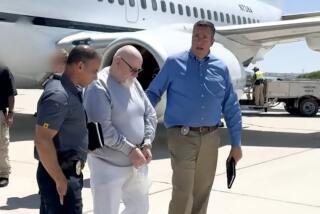Graphic photos displayed as serial-murder trial opens
Displaying gruesome photographs of strangled women with bloated faces, a prosecutor told jurors Tuesday that he would prove Chester Dewayne Turner was one of Los Angeles’ most prolific serial killers.
“These are the victims of a killer,” said Deputy Dist. Atty. Bobby Grace, gesturing at the photos. “Today we can say the name of that killer: Chester Turner.”
Turner, 39, wearing a neatly pressed blue shirt, watched closely as the prosecutor’s statements launched a trial that could lead to a death sentence.
The defendant has pleaded not guilty to committing 11 murders in the 1980s and ‘90s. Prosecutors said they are prepared to prove that DNA links him to the deaths. Turner’s lawyer, John Tyre, reserved the right to make his statement to the jury later.
All the victims were found strangled, Grace said. Turner, 6 feet 2 and 260 pounds, used his hands and an electrical cord to kill his early victims, the prosecutor added.
Grace painted a picture of a spreading crack cocaine epidemic in a time of “joblessness and hopelessness which created despair among the residents of South Los Angeles.” Most of the slain women had used cocaine and were found partially nude; many have been identified as prostitutes.
“Many residents wanted to escape from what was going on. To do that, some of them turned to drugs,” Grace said.
Turner’s defense is expected to contend that he was a drug dealer and that most of his customers were prostitutes who often paid in trade, explaining the DNA evidence.
Jurors in the trial at downtown’s criminal courts building won’t hear how police earlier arrested another man in three of the killings they now attribute to Turner. David Allen Jones was convicted and served 11 years before DNA tests cleared him and he was freed in March 2004 from prison.
Jones has an IQ of 60 and speaks like a third-grader, according to his lawyer, yet he confessed after interrogation to being the serial killer who had cleverly evaded detection for years. Jones received $720,000 in compensation for his false conviction and time in prison.
Grace used a projector to map sites of the crimes, as well as four places where Turner lived, along the Figueroa Street corridor north of the 105 Freeway.
Then he said the last two victims died seven miles away, in downtown Los Angeles around skid row. “Lo and behold, that’s where Chester Turner was living and working at the time in 1998 when these victims are killed,” the prosecutor said.
Grace spoke for 90 minutes, saying the serial murders were in areas “where the killer could ply [his] murderous trade and steal away undetected.”
The veteran prosecutor also challenged jurors.
“How long could you wait for justice? Ten years? Five years? A lifetime?”
The victims, in the order they died, were Diane Johnson, 21; Annette Ernest, 26; Anita Fishman; Regina Washington, 27, and her unborn child; Andrea Tripplett; Desarae Jones, 29; Natalie Price, 31; Mildred Beasley, 45; Paula Vance, 38; and Brenda Bries, 37.
There were no witnesses to any of the crimes, but there was a surveillance videotape of the Vance killing. The grainy black and white images showed a man and a woman in an alley, with the last frame revealing the victim as she was found by police.
The Turner case was used to promote Proposition 69, an initiative that passed in 2004 and was designed to create a DNA databank of people arrested in felonies.
*
More to Read
Sign up for Essential California
The most important California stories and recommendations in your inbox every morning.
You may occasionally receive promotional content from the Los Angeles Times.










